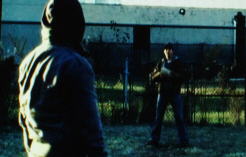
Anyone thinks Steven Spielberg will miss an opportunity to pay visual homage to Orson Wells in the upcoming film War of the Worlds, think again


Since Spielberg already said he was inspired to do the movie because he had purchased an original script from the 1938 Halloween radio broadcast, you can expect him to make specific and repeated visual references to Wells' greatest work, Citizen Kane. Even the locating a good portion of the film's geography in New Jersey seems to echo the repeated references to New Jersey Wells made not only in having the aliens invade New Jersey but in references and locations in Citizen Kane.




While Spielberg appears to use Wells techniques in other films, War of the Worlds - from what has been unveiled so far - seems to be more heavily influenced, suggesting a deliberate effort to make the visual connection. Spielberg seems to use Wells like angles, physical backdrops (such as the Bayonne Bridge), shadowy sets, cinematically similar shots in order to pay tribute to what has been called the best American film ever made. You can find shots in both the trailers and in Kane are shot from below such as when Tom Cruise reaches up to the porch. Spielberg also makes liberal use of shadow in many of his trailer shots, often with features of characters lost in moody angles of light as in many of the kitchen scenes very similar to Kane. As with Wells, Spielberg uses characters at different depths such as when Cruise is playing catch and in the kitchen scenes, very typical of Kane.


A window scene - presumably showing people looking out at the crumbling of Newark - may also reflect scenes of the Kane and the editorial staff looking out over the city they cover. Reflected faces in glass is typical in both Wells' work as well as Spielberg's as is having the camera look down upon characters from above such as Kane standing amid stacks of his newspapers. Both film makers use devastated landscape for effect, such as the lone character walking back to the ruins of the exploded bridge in the trailer and the lone Kane strolling through the ruins of his campaign for governor.


While Spielberg is a master of frame shots, some of those that appear in the trailers - such as dividing character with the use of windows in the van scenes (my favorite showing the angry man charging the van through the rear side window) are very evident in Kane with one particular scene that takes place in the Atlantic City night club where the frame is broken up by the phone booth - the reporter inside, the club owner framed by the phone booth door, and Kane's mourning wife isolated by the wall of the phone booth


Although only briefly glimpsed in Kane, even Spielberg's bridge seems to be a tribute - echoing many of the other arched patterns Wells made frequent use of in Kane.


Of course, this does not mean that Spielberg won't make references to other classic films in War of the Worlds - such as the shot of Dakota looking out the rear window of the van at the bridge.